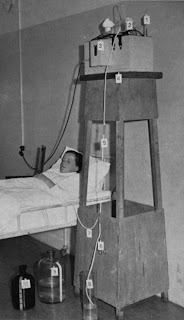The first successful mode of dialysis for acute renal failure and still not replaced
The beginnings of haemodialysis have been described many times, but the first successful peritoneal dialysis probably antedated the first successful haemodialysis by 7 years. Peritoneal dialysis was undertaken alongside haemodialysis in most renal units from the early 1960s, but also in many hospitals without renal units, and numbers are poorly recorded.
The first successfully treated patient was probably a patient with obstructive acute renal failure (ARF) at Wisconsin General Hospital, reported in 1938, and further success was reported from Boston by Fine, Frank and Seligman in 1945, about the same time as Kolff’s first successful haemodialysis. In the UK a 36 year old woman with ARF caused by mismatched blood transfusion was successfully treated by urologist Ronnie Reid in 1946.
 These results followed years of research into the use of the peritoneum for dialysis, particularly by individuals and groups in Germany and the USA. Its use in patients with renal failure was reported by Ganter in 1923, but the familiar problems of peritonitis, leakage, drainage difficulty, and learning curve with electrolyte correction and fluid balance made early experiences discouraging.
These results followed years of research into the use of the peritoneum for dialysis, particularly by individuals and groups in Germany and the USA. Its use in patients with renal failure was reported by Ganter in 1923, but the familiar problems of peritonitis, leakage, drainage difficulty, and learning curve with electrolyte correction and fluid balance made early experiences discouraging.
In 1959, the year haemodialysis began to catch on in the UK, Morton Maxwell and his team in Los Angeles described a simplified and improved closed infusion/drainage system joined to a rigid catheter introduced in the midline through a trochar. They were responding to the difficulties of using the Kolff twin coil artificial kidney machine, which they described as a ‘formidable and costly procedure’. Their case histories reveal how much of a last resort dialysis was at the time. It was often not introduced before the patient was in extremis.
Paul Doolan, writing the same year from a naval unit which had used HD since 1950, described similar value (and problems) with a closed technique but with improved catheters that were the forerunners of modern PD catheters.
Maxwell’s technique has lasted and is in use in many parts of the world still – except that the use of pharmacy-mixed dialysate in glass bottles has mostly been superseded. Some centres continue to use rigid catheters rather than soft ‘Tenckhoff’ types, probably for reasons of cost. It remains important as a treatment for acute renal failure worldwide. Rigid catheter design was improved by the ‘Trocath’ introduced by Weston and Roberts in Los Angeles in 1964, which was inserted around a sharp stylet instead of through a hollow trochar, so reducing leakage.
However successful longterm use of PD for end stage renal failure required further technical progress.
Further info:
J. Stewart Cameron 2002. A History of the Treatment of Renal Failure by Dialysis (OUP)
Doolan PD et al. An evaluation of intermittent peritoneal lavage. Am J Med 1959 26:831-44
Maxwell MH, RE Rockney, CR Kleeman, MR Twiss. Peritoneal dialysis 1: technique and applications. 1959 JAMA 170:917-24
A fuller history of peritoneal dialysis was once published by the ISPD, but it now seems to be unfindable … instead try Andy Stein’s History of PD (renalmed.co.uk); or Fresenius have a good but unillustrated account; but Russell A Palmer’s 1982 nicely illustrated account from PD International is open access. Russell Palmer was an impressive pioneer himself in HD as well as PD, and with Quinton introduced the first silicone PD catheter (MacBride P Perit Dial Int 1981 1:156–158).
Boen ST 1959. Peritoneal dialysis – a clinical study of factors governing its effectiveness. PhD thesis, University of Amsterdam
The early history of dialysis (Edren)
Illustrations from Boen as above, and from Maxwell 1959 as above (all rights reserved by JAMA). This article will be published in the Journal of Renal Nursing in August 2009